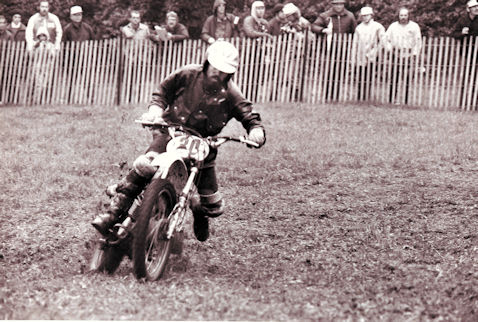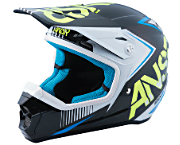© 2019 by Bill Uhl, ATV Expert Witness

Bill Uhl competing upon his Penton motorcycle in the final special test, on his way to becoming the top placing American rider at the 1973 ISDT in Dalton Massachusetts.
As a Court-Qualified Expert Witness regarding safety training to prevent accidents when riding ATVs, UTVs, snowmobiles and motorcycles (dirt bikes, dual sports and street bikes), I’m often asked to explain how my professional passion and background created my current career.
The 1973 ISDT (International Six Days Trial), known as The Olympics of Motorcycling, was held in Dalton, Massachusetts. It was the first time this event was held in the United States in its 60-year history. The ISDT is the longest running motorcycle event in the world, spanning 106 years, from 1913 to 2019. (In 1981, the event name was changed to ISDE, International Six Days Enduro.)
The event began as a way for manufacturers to test products before mass production and sale to the general public. Since manufacturers were testing their products, the decision was made to also test machine operators (motorcycle dirt bike riders). Competition was world-wide and highly intense. Riders competed for gold, silver and bronze medals in some of the most difficult motorcycling conditions and terrain in countries around the world. Competition rules included the following.
- All motorcycle parts were marked with special paint. Each rider was assigned a competition number that was included in the painted area. The goal was to ensure that machine parts were not changed during the event.
- The motorcycle’s cylinder and cylinder head were wired and sealed together so riders could not replace any internal parts.
- The engine was wired and sealed with a lead seal that contained a special mark connecting the engine to the frame so the engine could not be removed.
During the event, a rider was only allowed to change normal wear-out items, such as tires, chains, and cables. Other components had to go the distance, which meant over 1,000 miles of on and off-road riding during the 6-day event.
Adding to the challenge, only the rider could work on his motorcycle. This meant riders had to be both good mechanics and light on their wheels so they would not damage their motorcycles. As you might guess, I was meticulous about what I could control, including conducting a careful pre-ride inspection. Of course, during a 6-day motorcycle event, riders are constantly checking the condition of their bikes to prevent problems. (Click here to learn about the importance of pre-ride inspections before you ride any OHV.)
A rider’s pit crew was allowed to put gas and oil in the motorcycle and air in its tires. The crew was not allowed to conduct bike maintenance or repairs. The crew was allowed to give the six-day rider food and water or routine things like cleaning their goggles / glasses and temporarily providing a place for the rider to get out of harsh weather, which included everything from blizzards to blazing sunshine and heat.
Retreating from severe weather conditions may sound reasonable, but the only “extra time” riders had available were the minutes and seconds they created if they covered a certain section of the travel route faster than the schedule for that day because the event was timed from start to finish, much like a rally. The rider was required to maintain a specific speed average between every check point.
Even though some rules changed over time, the essence of the rules still remain. The 1981 name change from ISDT to ISDE, International Six Days Enduro, was a response to the growing influence the Americans had on motorcycle manufacturers across the world. ISDE employed a specific type of dirt bike motorcycle designed for Enduro type riding. In other words, ISDE reflected the change in how motorcycles were manufactured for specific types of use (on and off road), featuring skills more associated with cross-country and motocross racing.
As an illustration of how strict competitive rules were, after bike parts were marked and sealed, the motorcycles were impounded and locked away from the riders until the event began its 6-day journey around the countryside of whatever nation the event was held in.
During the early years, the country that won the event became host of the event the next year. Some countries won the event so often that it was decided that the winning country could pass the next year’s event to another country. That’s how the United States got to host its first ISDT in 1973 in Dalton, Massachusetts. Al Ames, known as “Mr. Berkshire”, had been running events for years in his area. He was elected to design and lay out the route for the first International six-days Trials to be held in the U.S.
Enjoy the motorcycling history shown in this four-part video series of the 1973 event.
From the Foundation to the Present
Note: Article #2 of this 4-part article series will discuss how the International 6-day Trials shaped my life and created a series of unexpected careers.
- Passionate motorcycle dirt bike rider, beginning in 1956 before my feet touched the ground when sitting on what was used as a dirt bike at that time in history.
- Motorcycle dirt bike competitor, starting in 1960, eventually resulting in winning 5 gold medals for the U.S. at the ISDT / ISDE.
- Co-owner of an off-highway vehicle retail store.
- Mechanic for off-highway vehicles (OHV).
- Research and development associate (R&D) for off-highway vehicle manufacturers.
- Off-highway vehicle trainer for riders of all-terrain vehicles, quads, 4-wheelers, (ATV), utility vehicles (UTVs, side by sides, ROVs, RZRs), snowmobiles and motorcycles of all types (street and dirt). Click here to read about why safety training is essential to prevent OHV accidents and injuries, whether you’re operating an ATV, motorcycle, UTV, snowmobile, etc.
- Instructor trainer for all of the different types of off-highway vehicles above, including for branches of the Military Special Forces and corporate and government clients.
- Trail maintenance and construction designed to ensure safe trails for all types of users such as:
o mountain bicycles
o horses and lamas
o hikers
o motorcycle dirt bikes
o dual-sport motorcycles
o other off-highway vehicles
o and even people with limited eyesight, or blind and citizens confined to wheelchairs of the sporting type designed for off-roading.
All of the above helped set the stage so I could be of service to the legal community and their clients as a Court-Qualified Expert Witness in the above areas. At present, I’ve assisted attorneys representing both plaintiffs and defendants in over 75 legal cases. The cases related to off-highway vehicle safety training (or lack of), personal injuries, off-highway accidents, off-road vehicle tours / guided tour issues, trail construction problems, street-bike motorcycle accidents, motocross incidents, snowmobile accidents, etc. Click here for more information.
NOTE: This article is not intended to be all inclusive. It is designed to provide a foundation for the reader to learn from.
Bill Uhl is a Safety Trainer and Court-Qualified Expert Witness for cases involving all-terrain vehicles (ATVs), utility vehicles (UTVs / side by sides / ROVs), snowmobiles, motorcycle dirt bikes, dual sport bikes and off-road bicycles. Uhl has completed over 75 cases while serving as an Expert Witness, including trial testimony. Click here now for more information.


